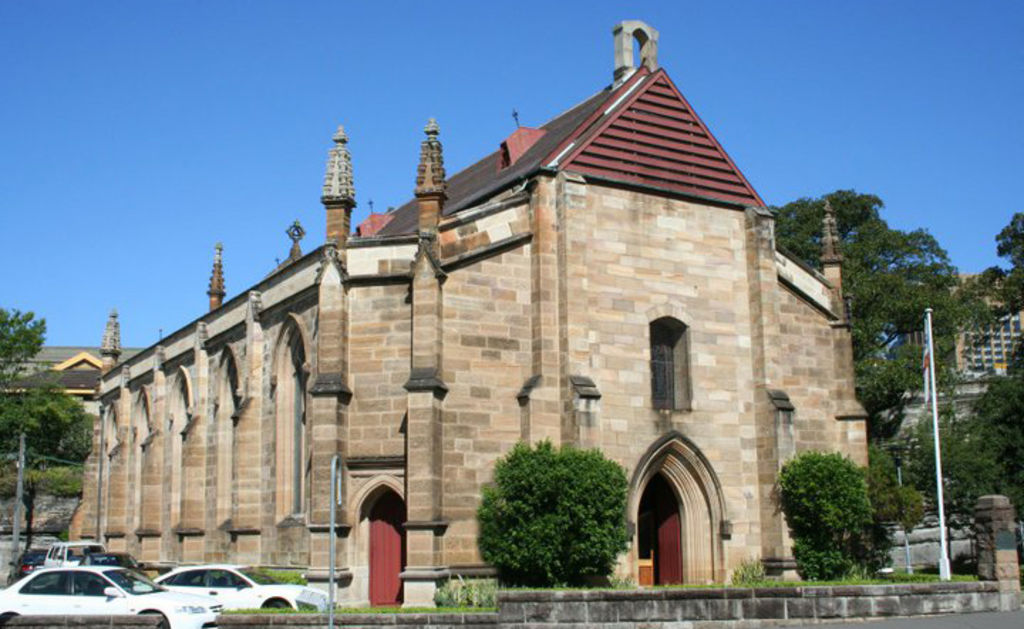
Garrison Church appeal: Historical linchpin of contentious Millers Point now needs help too
There’s a signboard outside the 175-year-old sandstone church in the middle of Sydney’s controversy-torn suburb of Millers Point. “Hello!” it says. “We’d like to meet you.”
And that’s aimed at everyone, insists the Reverend Justin Moffatt, the rector of the Holy Trinity Anglican Church, better known as the Garrison Church.
It’s a message for both those who are battling the State Government to be allowed to stay in their homes in an area that was the first in Australia to have public housing, and the appreciably better-heeled who are flooding in to either snap up their neighbours’ newly vacated heritage properties or buying up big in the parish’s newest real estate strip, Barangaroo.
It’s a congregation that’s home to the poor, now side by side with the rich.
 The Holy Trinity church 1872. Photo: Pickering, Charles Percy (NSW Government Printing Office)
The Holy Trinity church 1872. Photo: Pickering, Charles Percy (NSW Government Printing Office)
“We want to be friendly to everyone,” says Reverend Moffatt, 46, speaking on the eve of another important date for the church, too – the 160th anniversary of the eight-hour day beginning in Australia, a workers’ victory that started with a strike by the stonemasons building the church.
“We want to see everyone, whoever’s living in the area or wants to come by. We have people here of all ages, from newborns to nonagenarians. We’ve been here for 175 years, and we’re open to everyone.”
But just as Millers Point is going through a period of either devastation or renewal – depending on who you talk to, with the emptying and sell-off of public housing in Millers Point, the removal of tenants from apartment block Sirius and the development of Barangaroo – so too is its heritage-listed church.
The Millers Point parish has joined that of the nearby St Philip’s Church, Sydney – the first church to be built in Australia – to create the Church Hill parish, combining church resources.
 The Holy Trinity Anglican Church, better known as the Garrison Church, in Millers Point. Photo: Supplied
The Holy Trinity Anglican Church, better known as the Garrison Church, in Millers Point. Photo: Supplied
Reverend Moffatt is now also about to launch an appeal for money for a new roof after, biblically speaking, the heavens opened in May last year and sent a Noah’s Ark-like flood pouring through the nave of the 1840 mixed gothic Garrison Church. The 50-strong congregation had to abandon the service.
“The roof leaks on the congregation and during the heavy downpour last year, the box gutters overflowed … as they were singing in the middle of the service, a river came through,” says Reverend Moffatt, who was transferred to the church two-and-a-half years ago. “It spilled into the church and down on to the wheelchair access.
“It’s like inviting people to dinner and you want them to have a good time, and be part of the family, but then water falls down on to the dining room table.”
That family includes many of the original, and now doomed, residents of Millers Point. Bev Sutton, the last of four generations living at Millers Point and soon to leave, is one of the founders of the first action group to battle the sales plans, the Committee of Residents Elected.
She says the church has been a strong ally in the group’s work.
“The new minister is active and has been very keen to help us, as well as regenerate the congregation,” Ms Sutton says. “I’ve spent a lot of time at church over the years, but I think that heaven and hell is here on earth.”
 The Holy Trinity Anglican Church is not taking sides in the debate over Millers Point. Photo: The Garrison Church, Facebook
The Holy Trinity Anglican Church is not taking sides in the debate over Millers Point. Photo: The Garrison Church, Facebook
The church has hosted some meetings, and the rector says he’s been giving “quiet pastoral care” to some parishioners involved and in need.
Now his own church is in need too, with the cost of the new roof estimated by heritage engineers as $514,000. Welsh slate, specially cut according to imperial measurements, needs to be brought to Australia to replace the slate already there.
The State Government has already pledged $150,000, as long as the church can at least raise the same amount, to the appeal being run with the National Trust’s conservation office.
“It’s such a high-profile church because of its early history, being used by the military and locals since the 1840s,” says David Child, conservation appeals officer of the National Trust of Australia.
“By coming with the National Trust, anyone who donates to an appeal can get a tax deduction too, so there’s also a financial incentive to donate to contribute to the church’s restoration.”
 The Garrison Church was Australia’s first military church. Photo: David Lochlan
The Garrison Church was Australia’s first military church. Photo: David Lochlan
Most at Millers Point are keen to see the infrastructure maintained of what’s become one of Australia’s newest prestige suburbs after the sale of so many of its state housing heritage-listed properties, with the average price for the homes on Lower Fort Street and Argyle Street around $3.56 million.
So far, the auctions of 70 properties have brought in more than $180 million the NSW government says it is re-investing into 1500 new social housing dwellings across the state.
Nine more are to go to auction on May 2, on Lower Fort Street, Argyle Street and Kent Street. With prices at Barangaroo reaching $10.5 million for a penthouse, and James Packer’s hotel-casino complex reported to be ready to sell a penthouse that could approach $100 million, it’s hoped that new neighbours such as entrepreneurs and big developers might also pitch in.
“We’d love anyone to contribute, even if it’s only $5 from a couple who married here and have happy memories of the day,” says Reverend Moffatt, who was the rector of churches in Sydney’s St Ives as well as in New York before going to Millers Point.
 More than half of the growing congregation of the Garrison Church is under 35 years of age. Photo: Supplied
More than half of the growing congregation of the Garrison Church is under 35 years of age. Photo: Supplied
“Or it might be members of the congregation, or locals who don’t come here on a Sunday but still feel a strong sense of ownership of the area and its church.
“We also have a lot of new young people here. Twenty years ago, no one wanted to live in the city – they were moving to the suburbs – but now they’re coming back in, and the average age of the church has halved in the past five years.
“Our congregation is growing and over half would now be under 35.”
- Donations can be made through the church’s website; by email – office@churchhillanglican.com or by phoning (02) 9247 1071.










